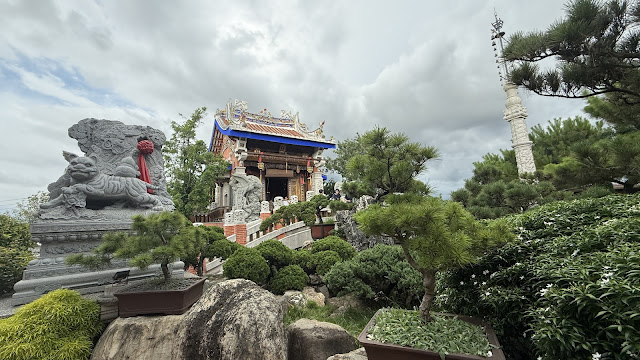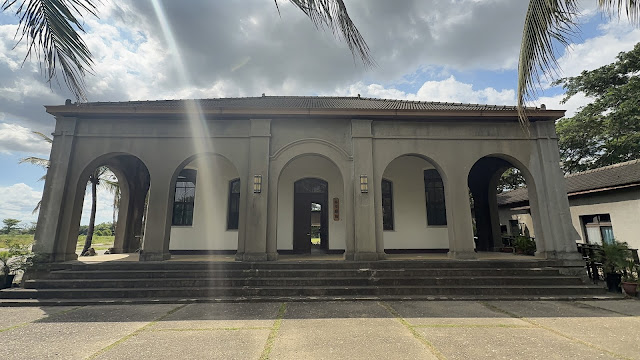Travel Date: 2025/06/21
Are you dreaming of a place where serene nature, rich culture, and spiritual peace intertwine? Look no further than the Ningji Yuting Garden Landscape Cultural Park (寧濟御庭園林山水文化園區) in Douliu, Yunlin. This magnificent Chinese-style garden is not just a feast for the eyes; it's an architectural marvel built with an investment of over a hundred million NTD, offering free admission and ample free parking – even for tour buses!
Nestled peacefully on Zhenliao Road in Douliu, near the Yunlin Science Park, Ningji Yuting feels like stepping into a hidden royal garden. Spanning approximately three acres (about 3,500 ping), every corner of this meticulously designed park exudes the timeless elegance of a classical Suzhou garden. Imagine strolling past exquisitely crafted pavilions, serene water features, intricate stone sculptures, and vibrant green landscapes. From the auspicious "Golden Rooster Announcing Good News" at the entrance to the subtle beauty of various flowers like camellias and azaleas, every detail transports you to a bygone era.
Ningji Yuting is more than just a picturesque spot, it's a profound expression of gratitude and spiritual devotion. Established by a prominent local construction company, the park was founded as a heartfelt dedication to Mazu, the Goddess of the Sea, who guided the founder through challenging times. This deep spiritual connection permeates the entire park, creating an atmosphere of peace and harmony.
The park's name, "Ningji," originates from the revered King Ningji of Quanzhou, while "Shunji" refers to the Mazu Temple in Quanzhou. This historical and spiritual lineage is beautifully embodied in the park's layout and deities.
Your journey through Ningji Yuting is a "100-point blessing path." You'll cross the Ruyi Bridge (Bridge of Auspiciousness) and the Yingxian Bridge (Bridge for Welcoming Immortals), gazing into the crystal-clear waters of Fuhai (Fortune Sea) where fish gracefully glide. Don't miss the rare Green Jade Ancient Warship, a century-old masterpiece that has become a viral hotspot for social media photos! Take a moment to enjoy a cup of warm "Immortal-Welcoming Peace Tea" and feel your spirit uplifted amidst the blooming flowers and the peaceful rustling of pines.
Beyond its undeniable aesthetic charm, Ningji Yuting serves as a significant spiritual center. Within its tranquil confines, visitors can pay respects at various halls dedicated to different deities:
- Sanyuan Hall: Honoring the God of Wealth, complete with a massive golden ingot and offerings.
- Da Guanyin Pavilion (Great Guanyin Pavilion): Housing the White Jade Guanyin, Thousand-Handed Guanyin, and Zhengxiang Guanyin, where you can admire the exquisite interior decorations.
- Ningji Wangye (King Ningji) & Dragon King: Found in the main temple complex, featuring stunning modern architecture complementing the gardens.
- Wenling Mazu: Tucked away in the innermost part of the park, this temple is dedicated to the White Jade Mazu, renowned for her pure, translucent beauty. Notably, Ningji Yuting is the only place in Taiwan where you must cross the Ruyi Bridge to worship the White Jade Mazu, adding to its unique charm.
The park actively integrates traditional culture and spiritual practices. During Chinese New Year, special events like the "Heavenly Official Bestows Blessings, Auspicious Door" are held, featuring enchanting guzheng performances that blend music and spiritual ceremony, creating a truly moving experience. You can also engage in traditional practices like lighting incense and lamps, and even seek blessings for love at the Yue Lao (Matchmaker God) shrine.
For photography enthusiasts, Ningji Yuting is a dream. The arched bridges, serene water features, and majestic temple buildings create an ethereal backdrop for stunning photos. It's no wonder this spot is a favorite for influencers! The blend of traditional Chinese architecture and lush natural scenery provides endless captivating shots.
The park's accessible design, combined with its free admission and ample parking, makes it an excellent choice for families and elders seeking a peaceful and enriching outing. On weekdays, the park is wonderfully quiet, allowing for a deeply meditative experience.
Ningji Yuting is perfectly situated for a full day of exploration in Douliu. It's conveniently close to other popular attractions, making it easy to create a comprehensive itinerary.
Here's what you need to know for your visit:
- Address: No. 195, Zhenliao Road, Douliu City, Yunlin County, Taiwan
- Admission: FREE all year round!
- Parking: Ample free on-site parking is available.
- Pet Policy: Pets are welcome, but must be carried (not allowed to walk on the ground).
- Opening Hours:
Weekdays (Mon-Fri): 9:00 AM – 11:30 AM & 1:30 PM – 5:00 PM (no appointment needed)
Weekends (Sat-Sun) & Public Holidays: 8:00 AM – 6:00 PM
1st and 15th of each Lunar Month: 10:00 AM – 5:00 PM









































































